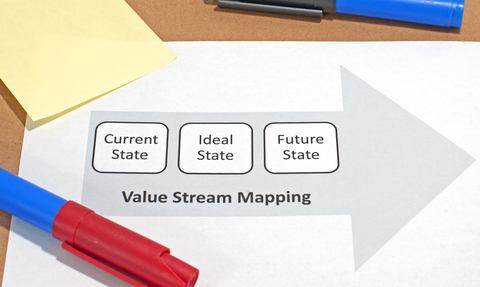Phyllis just returned from speaking at Print18 in Chicago. The following is some insights from her trip
Seth Godin gave an engaging, informative keynote speech. Seth provided insights into Buyer 2.0 and how to market to today’s educated, connected buyer. I was delighted to find that my speech linked to the points he made. In this blog post, I will discuss highlights from my speech about creating a Lean sales process that maps the value of your product or service to the prospect and allows you win more sales in a Buyer 2.0 environment.
Eliminate waste and target the right prospects
Neither buyers nor sellers can afford to waste time or money. Yet marketing efforts and sales presentations are often not aligned and that leads to wasted time for both the buyer and seller starting in the prospecting phase. The misalignment can also cause lower sales results and create problems in operations. Ultimately, it has a negative impact on the entire organization. “How is that possible?”, you ask.
Well, a lead that doesn’t qualify will fall out of the pipeline at some later time. This is a waste of time and resources for both the salesperson and the buyer. It also impacts operations because it leads to an inconsistent flow of product orders for production. The lack of an even flow of orders causes peaks and valleys in labor needs and in ordering raw materials which impacts costs as well as relationships and employee engagement.
What is Value Mapping?
So, what is value mapping and how can it give you a competitive edge? Value mapping is a Lean process that helps salespeople set qualification criteria along multiple dimensions. This allows salespeople to allocate their efforts based on standard measures of the quality of the prospect, customer, or a lead. According to experts, the development of solid qualification criteria is one of the most underused techniques in sales process improvement, yet it produces outstanding time and money savings as well as increased closed sales.
A qualification criteria allows sales people to spend time with valid opportunities and not waste time with prospects that don’t fit with your product or service. You will save time in driving, on the telephone or in-person calls, and in preparation of quotes or proposals.
Value mapping also allows salespeople to focus on what is important to Buyer 2.0 and to provide insightful questions that will move the sales process forward. Buyers are educated and connected. They do not want to waste time with salespeople that don’t understand their issues, needs, and values. Research proves that salespeople are more successful and more engaged when they work with marketing. Together they must ensure they are communicating the same value message, targeting the right prospects, and closing more deals.
How to get started value mapping for success
Step 1
So, lets walk through the steps to create value maps. The first step in creating a value map is to collect internal and external information to create a qualification guide. Speak with your current customer base and then research the Internet, social media, and industry groups to determine their view of the benefits a customer will realize from investing in your product or service. Has the customer realized a savings? Did your product or service allow them to generate increased revenue? Does it enable them to improve their service?
Step 2
Assess the value to your company. Why should your company pursue an opportunity to do business with this prospect? Will the prospect bring current and future revenue that makes the sales time profitable? Will the prospect provide an increase in market share? Will the prospect give you a greater edge over competition? Will this account bring greater visibility in the industry or media?
Step 3
Next, ensure the prospect can qualify financial level. At this point, it is not the exact amount and you have not received data from the prospect. However, you can check their Better Business Status, their stock, and business rating if they are on the stock market, and you can check if there are any outstanding liens or legal actions against the company.
Step 4
Finally, what is the effort required to obtain a sale? Is this a showcase account for the competition? Do we have a clear advantage over the competition? Do you know the mindset and type of decision maker (early adopter, go with the crowd, late adopter, analytical, social)? Do they have the internal power and persuasion capabilities to make the decision in your favor?
Putting It All Together
Once you gather the above information, map the value into a form. Assign numerical values for each value characteristic category and its attributes. As you move the prospect through the sales cycle, you can validate that the assigned values continue to be correct or they need to be adjusted. The more you work with value maps, the more skilled you will become in assessing prospects and assigning values. The maps will also allow you to create a profile of the ideal prospect and the values important to her or him.
Sales and Marketing succeeding together
Marketing will appreciate sales sharing the value maps and ideal prospect characteristics. It will allow them to create targeted marketing campaigns that are more effective. As an example, one company found they had customers in multiple industries. The marketing department created customized marketing campaigns for each industry and included messages that relate to the targeted prospect. Targeting the right prospects and asking the right questions to uncover the values that are important to them provides a competitive edge. It also develops relationships and helps you create insightful conversations. I’ll continue in the next blog post with more on how Lean can streamline the sales process and give you a competitive edge. You can learn more about each of these topics in other blog posts and podcasts on our website: www.salestrainingsolutions.com.
About the Author: Phyllis Mikolaitis is a sales coach, author, and speaker with over 30 years’ global experience. She is dedicated to taking you beyond the typical “how to” courses to the heart of persuasion techniques incorporating insights and stories to win the sale. Phyllis has also had training in Leadership Through Quality, Six Sigma and Lean. Visit Phyllis and her business partner John Switzer on other pages on www.salestrainingsolutions.com. The links on our website allow you to listen to our podcasts or catch up on past blog posts on this and other sales topics.
For Lunch and Learn sessions, face-to-face or virtual training and coaching contact us at 703-819-5872.

